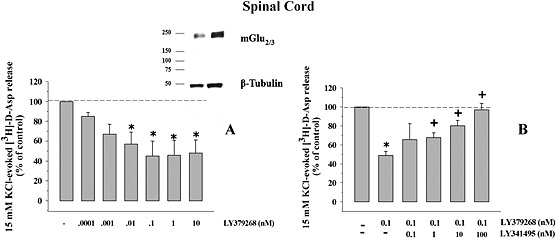Figure 2.

Presynaptic release‐regulating mGlu2/3 autoreceptors in spinal cord nerve terminals of adult mice. (A) Concentration‐dependent inhibition of the 15 mM KCl‐evoked [3H]‐d‐Asp exocytosis by LY379268. Synaptosomes were stimulated as previously described. Results are expressed as percentage of the 15 mM KCl‐induced overflow (% of control). The [3H]‐d‐Asp overflow elicited by 15 mM KCl corresponded to 2.18 ± 0.21% of the total synaptosomal radioactivity, and it amounted to 2.63 ± 0.5 nCi. Data are the means ± SEM of six to nine experiments run in triplicate (three superfusion chambers for each experimental condition). *P < 0.05 versus the 15 mM KCl‐evoked tritium overflow. (A, inset) mGlu2/3 receptor protein dimers exist in mouse spinal cord synaptosomes. Synaptosomal lysates were immunoblotted (10 μg protein, left lane; 20 μg protein, right lane) and probed with anti‐mGlu2/3 antibody and with anti β‐tubulin antibodies. The figure shows a representative Western blot of six analyses. (B) Antagonism by LY341495 of the inhibitory effect of LY379268 (10 nM) on the 15 mM KCl‐evoked [3H]‐d‐Asp overflow from mouse spinal cord synaptosomes. Results are expressed as percentage of the 15 mM KCl‐evoked tritium overflow. Data are the means ± SEM of six experiments run in triplicate. *P < 0.05 versus the 15 mM KCl‐evoked tritium overflow; + P < 0.05 versus the 15 mM KCl/10 nM LY379268‐evoked tritium overflow.
